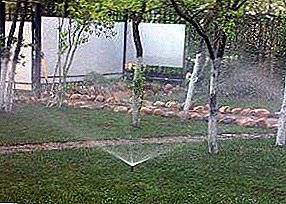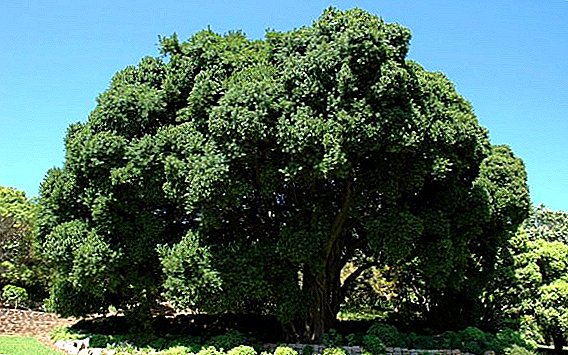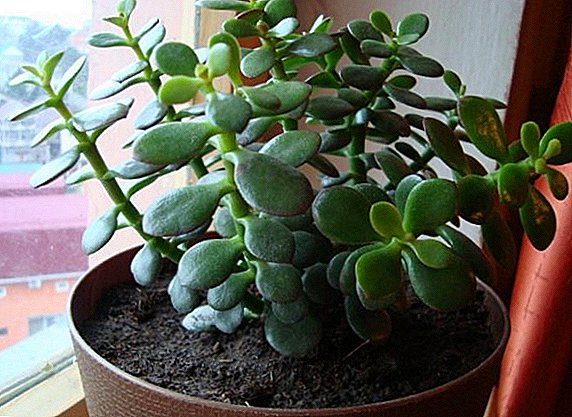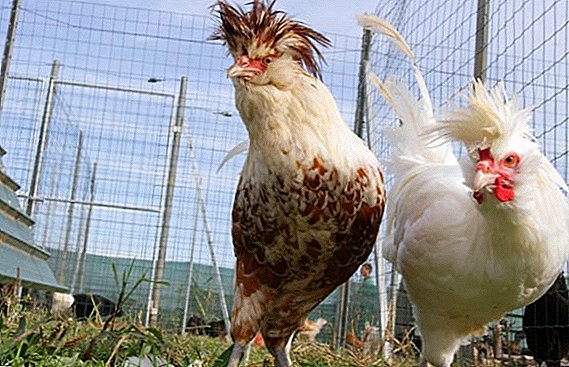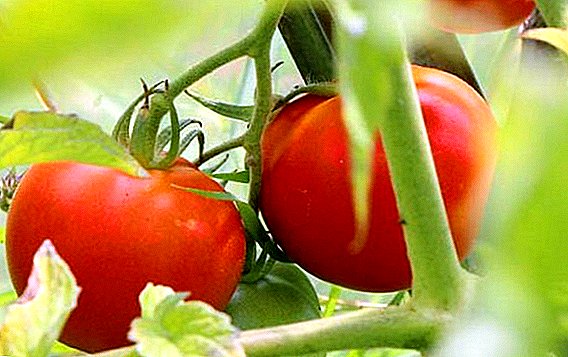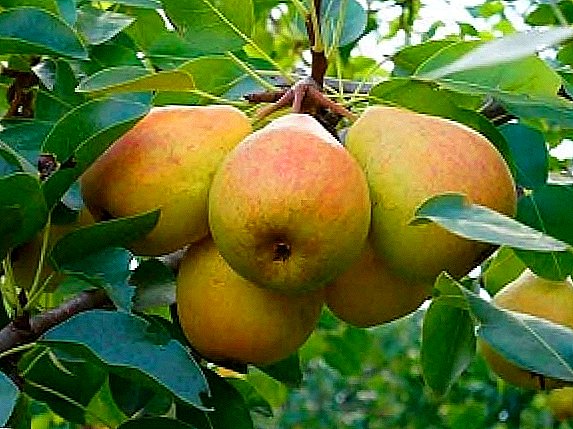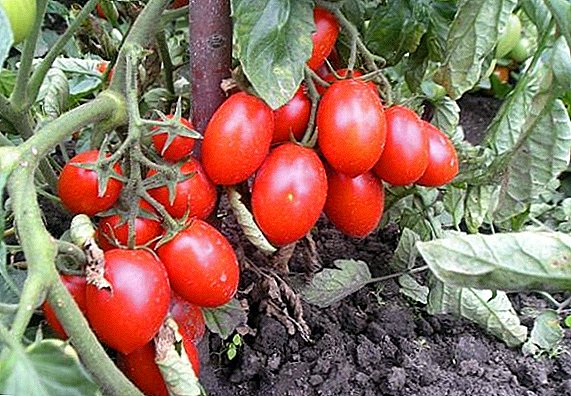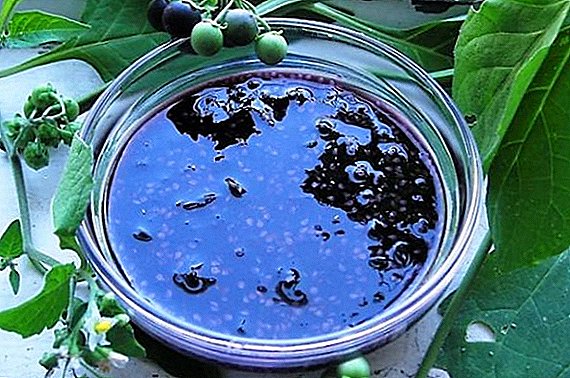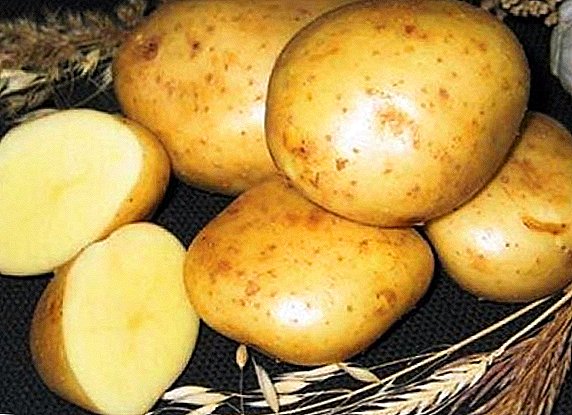 Growing potatoes cannot be called an easy task, but despite this, it is difficult to imagine a vegetable garden without it.
Growing potatoes cannot be called an easy task, but despite this, it is difficult to imagine a vegetable garden without it.
For some time, undeservedly forgotten variety potato "Lorch" again gaining popularity among gardeners.
Therefore, further we will discuss its description, characteristics and characteristics of cultivation.
Description and photo
The potato variety "Lorch" was bred in the early 20s. last century and is considered the oldest in Russia. Named in honor of its creator, the famous potato grower Alexander Lorkh, who devoted his whole life to the study and improvement of this beloved vegetable. The Institute of Potato Farming was named after him, which in 1976 gave the potato variety a second life.  Since inception, potato "Lorch" for many years was considered an elite variety for cultivation, on an industrial scale as well. Because of its high yield and unpretentiousness, it became a salvation for many people from starvation in the postwar years. But in the 50s for unknown reasons, the Lorch variety was completely abandoned and it was almost lost. Only thanks to the efforts of the breeders of the same institute it was possible to restore it.
Since inception, potato "Lorch" for many years was considered an elite variety for cultivation, on an industrial scale as well. Because of its high yield and unpretentiousness, it became a salvation for many people from starvation in the postwar years. But in the 50s for unknown reasons, the Lorch variety was completely abandoned and it was almost lost. Only thanks to the efforts of the breeders of the same institute it was possible to restore it.
Shoots
The bush of this variety consists of 4-5, less often 6-8 stems, which are slightly inclined, sprawling, up to 80 cm in height, and have the shape of a triangle or a square in cross section. In the lower tier, they form several branches, bright green. They have a lot of leaves, which are also bright green, medium size, slightly pubescent, with a weak dissection. The flowers are very delicate purple, consisting of five fused petals and a yellow pistil. After flowering, the berries rarely appear on them. The roots do not grow; therefore, neat, densely saturated with fruits, tubers are formed. 
The relatives of the potato among solanaceous crops are: sunberry, pepino, black nightshade, tomatoes and eggplants.
Fruit
Potatoes are very attractive in appearance, good presentation. Their weight ranges from 80 to 120 g. They are oblong in shape, more round than oval, and can be very elongated if there is not enough phosphorus in the soil. The skin is smooth, not thick, light beige, can peel a little near the top. There are very few eyes on potatoes, they are not deep, are located all over the skin. Under the skin is white flesh, which does not darken during cutting and heat treatment. By structure, it is not very watery and relatively soft in comparison with other varieties of potatoes. It contains a large amount of starch, from 15 to 20%, so the potatoes are boiled soft during cooking and well suited for baking.  The fruits also have excellent taste and persistence. In addition to starch, they contain 23% of dry substances, a little more than 2% of protein, and 18% of vitamin C.
The fruits also have excellent taste and persistence. In addition to starch, they contain 23% of dry substances, a little more than 2% of protein, and 18% of vitamin C.
Did you know? Potato berries are poisonous. For severe poisoning enough to eat a couple of pieces.
Characteristics of a variety
The main characteristic of the potato variety "Lorch" is its versatility. It is used in food and for the manufacture of starch. The latter contains on average 20%. Excellent harvest of potatoes brings in 110-120 days after planting in the ground. According to this indicator, the variety is ranked as middle-late.
As for the yield, from 10 square meters. m can collect up to 40 kg of potatoes. Vegetable growers say that the shrub is excellent, on average there are 15-25 medium potatoes in the tuber. The indicators of its "marketability" are also high, they range from 88 to 92%. The plant is unpretentious to the soil, resistant to pests and diseases. Of the latter, it can affect cancer and scab, but this does not happen often. It grows well in all latitudes, including northern.  Vegetable growers praise its wonderful taste, which is especially evident in baked fruits. Due to its high starch content, the variety belongs to cooking varieties, therefore it is ideal for mashed potatoes. The "Lorch" is not only a good presentation, it is also well kept until next summer.
Vegetable growers praise its wonderful taste, which is especially evident in baked fruits. Due to its high starch content, the variety belongs to cooking varieties, therefore it is ideal for mashed potatoes. The "Lorch" is not only a good presentation, it is also well kept until next summer.
We advise you to get acquainted with such varieties of kartoftolelya: "Kiwi", "Gala", "Good Luck", "Irbitsky", "Queen Anna", "Rosara", "Blue", "Red Scarlett", "Nevsky", "Rocco", " Zhuravinka "and" Cherry "(" Bellarosa ").
Advantages and disadvantages
The variety is popular for cultivation due to its high yield, simplicity and resistance to common diseases and pests. It requires no more care than other varieties, but the yield and quality of the fruit is at a very high level. Potatoes are not demanding on soils and do not need to be very fertilized. Ripens on average after 110 days. The root system of the bush does not grow, so all the fruits are collected in one place and they are very convenient to get out of the ground. You can grow such potatoes in any climate, even northern. Its changes do not affect the yield, it is consistently high every year.  They note the excellent taste of potatoes, its good transportation and keeping quality. The variety is still subject to certain diseases, and this is its main drawback. Also, gardeners say that it gives a weak crop if it is grown under straw. Some speak of late blight disease, but this is not characteristic of the variety.
They note the excellent taste of potatoes, its good transportation and keeping quality. The variety is still subject to certain diseases, and this is its main drawback. Also, gardeners say that it gives a weak crop if it is grown under straw. Some speak of late blight disease, but this is not characteristic of the variety.
Did you know? In Belarus, where potatoes are most loved, there is a monument to this vegetable and even a potato museum.
Landing features
Recently, growers have been experimenting with many ways of planting potatoes, but the main one is still planting in the ground. It seems that there is nothing difficult, but to get a good harvest and the fruit of the presentation, you still need the skills and the use of the recommendations of specialists.
Learn more about the features of growing vegetables such as: tomatoes, cucumbers, garlic, radishes, horseradish, peppers, carrots, zucchini and eggplant.
Timing
Potatoes varieties "Lorch" falls into the ground in the so-called standard time. Usually they fall on the end of April or the beginning of May. The earth should be warm enough. If it is cold, the plant springs up for a long time and its flowering is delayed. For planting, the optimum soil temperature is not below +8 ° C.
Choice of soil and location
Variety "Lorch" can be grown on any soil, it is not whimsical to them. For better effect, the soil should not contain a lot of clay and sand. The latter is generally not distinguished by good fertility, so it can be mixed with another soil, preferably with black soil. Strongly clayy soils, because of their low friability and water permeability, are also not very good. The plant will rise, but much later, and the fruits can be small and ugly forms.  The growing place should be sunny, if possible even to avoid stagnation of water. On shaded areas, the culture stems are pulled out, taking the sap from the roots, there is a poor flowering. In short, the shadow weakens the potato bush and the harvest will be bad. It is important to prepare the soil for planting. This should be done in spring and autumn. Before winter, the soil is cleaned, it is unnecessary plants and dig. It is better not to break the earth breasts, in the winter they will keep the snow and there will be more moisture. In the spring, before planting, the earth should be dug up again and loosened.
The growing place should be sunny, if possible even to avoid stagnation of water. On shaded areas, the culture stems are pulled out, taking the sap from the roots, there is a poor flowering. In short, the shadow weakens the potato bush and the harvest will be bad. It is important to prepare the soil for planting. This should be done in spring and autumn. Before winter, the soil is cleaned, it is unnecessary plants and dig. It is better not to break the earth breasts, in the winter they will keep the snow and there will be more moisture. In the spring, before planting, the earth should be dug up again and loosened.
Potatoes can not be planted in the same place every year. After it, the earth must "rest" for 3 years. Potatoes grow best on the ground after the roots: pumpkins, tomatoes, cucumbers, legumes.
Potato planting scheme
If seed germinates before planting, the crop can be harvested a couple of weeks earlier, and the quality of the seedlings themselves will be better. Sprouting usually begins one month before planting. For this purpose, the potatoes are taken out of storage and they create temperature conditions up to +12 ° С. They must be cleansed of earth. You can process them from pathogenic microbes by soaking in a weak solution of potassium permanganate for 15 minutes. For this, a solution of 3% hydrogen peroxide in the ratio of 1 tbsp. l on 1 l of water.  Next, the seeds are laid out in one layer, after some time they are examined for rot. They must also be periodically turned over and aired to the storage location. A week before planting, seeds can be taken out onto the street, where they will be planted in addition. For good germination, the length of the shoots must be at least a centimeter.
Next, the seeds are laid out in one layer, after some time they are examined for rot. They must also be periodically turned over and aired to the storage location. A week before planting, seeds can be taken out onto the street, where they will be planted in addition. For good germination, the length of the shoots must be at least a centimeter.
There are three ways in which Lorch potatoes are planted in the ground. The most common - alveolar. A shovel digs the hole at a distance of one from another to 40 cm. This is done because the bushes of this variety are tall and spreading, they should not interfere with each other. The depth of the fossa should be about 10 cm, and the width between the rows of planting should be about 70. The seeds go down into the holes, sprouting upwards and filled with earth. For a better harvest, this land can be mixed with a small amount of manure or compost, such fertilizers can also be put on the bottom of the hole. They are still advised to mix with the ground, because sprouts may suffer from direct contact with the fertilizer.  In gardens with very dry soil can be carried out planting in trenches. They are dug in the fall and put straw in it, which will retain moisture and will subsequently be an additional fertilizer. The depth of the trench is about 30 cm, the straw layer is half as much. At the time of planting, seeds are lowered into them at a distance of 30 cm from each other and fall asleep.
In gardens with very dry soil can be carried out planting in trenches. They are dug in the fall and put straw in it, which will retain moisture and will subsequently be an additional fertilizer. The depth of the trench is about 30 cm, the straw layer is half as much. At the time of planting, seeds are lowered into them at a distance of 30 cm from each other and fall asleep.
And for soils, where the water content is, on the contrary, very large, they use the ridge method of planting. With the help of a special technique, for example, a motoblock, they fill up ridges up to 20 cm high. The holes are dug into them, into which the seeds fall. The land is fertilized in the same way as when it is planted in the fossa.
Important! Potatoes varieties "Lorch" can not be cut for planting. This significantly reduces the yield.
Features care for the variety
Like any potato, the Lorch variety loves fertilized soil. Therefore, in the autumn, after digging a vegetable garden, manure or compost falls to the ground. They are added after digging in the spring. Nitrogen fertilizers can also be used in the quantities indicated on the original packaging. But Alexander Lorch, who cultivated a variety, believed that it was better to apply only organic matter, since chemical fertilizers spoil the taste and degenerate the potatoes.  The plant needs water, especially in the southern areas, so it must be actively watered, especially after the emergence of shoots, before the appearance of flowers, with active flowering and immediately after it. If the flowering period is dry and without rain, then watering should be no less than ten days.
The plant needs water, especially in the southern areas, so it must be actively watered, especially after the emergence of shoots, before the appearance of flowers, with active flowering and immediately after it. If the flowering period is dry and without rain, then watering should be no less than ten days.
So-called hilling is necessary when caring for any potato variety, including “Lorch” - including. The first time they spud a young plant, when it has grown to 20 cm. It is better to do this after rain, when the soil is wet. Under the base of the stem garden tools pour more land. It retains moisture for the bush, protects and provides additional oxygen. After three weeks, the process must be repeated.
It is also recommended to loosen the ground between the bushes and mulch it, covering it with straw. It does not grow weeds and retains moisture.
Important! In areas with hot climates, hilling is advised not to. The land above the bush creates additional temperature, and the Lorch variety does not like extreme heat. Therefore, you can only loosen and mulch the soil.
For excellent yield, it is advised to fertilize the soil at least three times. This is usually done during planting, before the first hilling and when the first flowers appear on the bush. When planting, you can fertilize the soil by mixing it with compost or manure. You can add a little ash. On one bush it should be up to 20 g. Of mineral fertilizers, you need to take those that contain nitrogen, potassium and phosphorus. They are better to fertilize, prediluted in the water. Before hilling, there will be a good solution of chicken manure in relation to water 1:15. Bush will need about a liter of such feeding. During flowering, a solution of 30 g of potassium sulfate per 10 liters of water will do. The solution is made at the rate of 1 l per 1 sq. Km. m
Pests and diseases
The potato variety Lorch is resistant to most common diseases and pests. But still there are times when plants can get sick cancer or scab. In the first case, on the potatoes appear growths similar to cauliflower, which rot and disintegrate the fruit. Such bushes must be immediately destroyed. Cancer affects not only the tubers, but also the soil, so potatoes cannot grow at this place for at least six years. For the prevention of disease using benomyl. How to use it is described in detail on the packaging. Correct crop rotation will also help to prevent the disease. A year before planting potatoes, crops are sown at the intended site, after which the cancer does not appear for 6 years.  Crop rotation helps fight scab, which covers potatoes with a net and forms growths. For prophylaxis, sideral fertilizers or "Trichodermin" can be added to the soil.
Crop rotation helps fight scab, which covers potatoes with a net and forms growths. For prophylaxis, sideral fertilizers or "Trichodermin" can be added to the soil.
Unfortunately, they have not yet come up with a sort of potato that does not eat Colorado beetle or medvedka. From such potato enemies are saved by various insecticides and folk remedies.  In a few years, we will celebrate the centenary of the appearance of Lorch potato varieties. And the fact that it is grown for such an amount of time speaks for its testing and reliability. Potatoes of this type are well kept and will delight you with their taste throughout the year.
In a few years, we will celebrate the centenary of the appearance of Lorch potato varieties. And the fact that it is grown for such an amount of time speaks for its testing and reliability. Potatoes of this type are well kept and will delight you with their taste throughout the year.


